
The Cruise
market in 2001
A year
of challenges
|
|
|
Being an active observer of the cruise market's
evolution over the last 25 years, we have seen how sensitive the sector is
to three external factors:
- an economic slowdown
- terrorist acts
- war
This passed troublesome year has experienced all three events
simultaneously which have weighed heavily over the cruise industry. The
last three slowdowns were caused by:
1985: the piracy on the 'Achille Lauro'
1991: the Gulf war
1999: the Kosovo war
The cruise market has always been able to recover from these crisis and
to frequently compensate these temporary slowdowns with a subsequent rapid
expansion.
We have not mentioned the overcapacity as we do not believe that this
is a major handicap to the market's development, as the industry has
always been able to absorb such surpluses by attracting new adepts to
cruising.
It is the ships which create the market, in the United States firstly
and more recently in Europe, and the increase in the number of cruise
passengers is always linked to the advent of new ships, as was the case:
- in the U.K. with the deliveries of the 'Oriana' and the 'Aurora',
- in Germany with the 'Aida' and the 'Deutschland',
- in France with the 'Mistral',
- in Italy with the new ships of Costa and Festival,
- in Spain with the 'Bolero' and the 'Oceanic'.
It is true that, if one of the causes mentioned above occurs, let alone
all three together, the potential overcapacity of the fleet exacerbates
the situation and depresses prices. However as in nature, there is a
natural selection which then takes over, and tends to eliminate the least
adapted ships and the weakest companies, thus allowing a quick return to a
more healthy balance. It is particularly true this year with the
bankruptcies of Commodore Cruise Line, Renaissance Cruises, and AMCV in
the U.S..
The year 2000 ended with a record orderbook of 50 ships under
construction (100,000 lower berths), which had financial analysts worried
and which had a negative effect on shares prices of companies quoted on
the exchanges. Nine months later, at the beginning of September, the view
of the main operators had become totally positive based on a load factor
of over 100 % in the U.S. with complaints only about minor price
reductions on offer. The drama of September 11th of course changed
everything and severely affected the tourism industry in general and the
airline sector in particular.
It is nonetheless amazing that apart from several days just after
September 11th, owners were able to fill their ships by lowering their
prices, which leads one to think that clients have not been put off the
idea of cruising and only need to be convincingly persuaded. If cruises
had suffered the same crisis in confidence as happened to air traffic, it
is unlikely that the same number of clients would have been as forthcoming
no matter what the price. Ships were relocated towards safer destinations,
with embarkations from the nearest ports for passengers, allowing them to
depend less on flight connections. During the last quarter, operators were
able to achieve average load factors of over 90 % in the U.S., which is a
remarkable achievement given the circumstances. Europeans have not by and
large changed their holiday schedules.
Companies that went bankrupt were already tottering before September
11th and this dramatic event simply added the coup de grace:
- Renaissance paid for their serious commercial mistakes, with a too
rapid expansion on a poorly defined market segment and too heavily
indebted.
- Commodore overspeculated within the gambling cruises in the U.S.,
where the relaxing of restrictions for playing on land no longer made
it necessary to play on gambling ships.
- AMCV which had high running costs due to American flag, suffered
from very aggressive competition of other cruise lines and of the
excellent infrastructures in the Hawaiian archipelago.
|
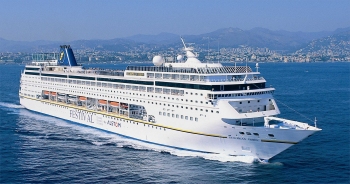 |
European Vision
56,600 tjb, blt 2001 by Chantiers de l'Atlantique, operated by
Festival Cruises |
|
| Orderbook
and deliveries |
|
For the first time in several years, we have
not seen any new orders, since the only one that was confirmed at the
beginning of the year was the second ship for MSC (60,000 gt, 1,560
passengers) with Chantiers de l'Atlantique which in fact was signed at
the end of last year. Several projects which might have got off the ground
this year, were postponed due to the slowdown and the events in the
market, such as with Disney Cruise Line, Radisson Seven Seas, Canyon Ranch
and Residensea.
The major owners, well-stocked with new ships, have taken advantage of
the lightening in the shipyard orderbooks, to delay certain deliveries and
to slip back the dates of some of their orders. This was the case for
P&O with Chantiers de l'Atlantique, RCCL with Masa Yards and more
recently Carnival with Fincantieri. The construction of a ship is a
partnership between shipyards and owners and such a decision can equally
be an advantage to the yard which having no new orders this year, risks
facing a lack of ships to be built in three years time.
|
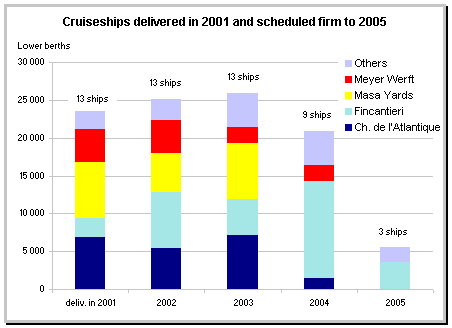
|
|
This slowdown in the pace of orders may in the medium term pose a
problem to European shipyards specialising in cruise ships, now facing
serious problems at finding substitute work, as the Koreans have taken a
dominant place in building LNG carriers and with orders for new ferries
being currently scarce. Among the large European shipyards, only
Fincantieri is well placed for the moment with an orderbook spread over
2005.
At the end of 2001, there remain 38 ships to be delivered:
- 13 in 2002, comprising 25,000 lower berths,
- 13 in 2003, comprising 26,000 lower berths,
- 9 in 2004, comprising 21,000 lower berths,
- 3 in 2005, comprising 5,500 lower berths.
It is however unlikely that the two cruise vessels being built at
Ingalls for AMCV will ever be completed (1,900 berths each) as cruise
vessels. These new ships represent over the next three years an average
increase of 8 % of the annual capacity which should easily be absorbed if
the market picks up to its normal rate of expansion of about 8 % p.a. as
well. In comparison the levels in 2000 were up by 17 % in the U.S. and by
20 % in Western Europe. In addition the market penetration is seven times
less prominent in Europe compared to the U.S., and should therefore grow
much faster in the future compared to the American market. Given this
situation, is it therefore still reasonable to harp on about overcapacity?
|
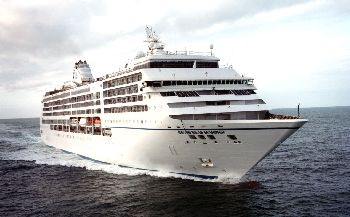 |
Seven Seas Mariner
47,900 gt, blt 2001 by Chantiers de l'Atlantique, operated by Radisson Cruises |
|
During this year the following deliveries have
taken place:
- For Carnival, the 'Carnival Spirit' and the 'Carnival Pride'
(85,700 gt, 2,114 berths) built at Kvaerner Masa.
- For RCC/Celebrity, the 'Summit' and the 'Infinity' (91,000
gt, 1,950 berths) built at Chantiers de l'Atlantique, the 'Adventure
of the Seas' (137,000 gt, 3,138 berths), built at Kvaerner Masa and
the 'Radiance of the Seas' (90,000 gt, 2,100 berths) built at
Meyer Werft.
- For Star Cruise/NCL, the 'Norwegian Star' (91,000 gt, 2,240
berths), built at Meyer Werft and 'Norwegian Sun' (77,000 gt,
2,000 berths) built at Lloyd Werft.
- For P&O Princess Cruises, the 'Golden Princess' (108,000 gt,
2,600 berths) built at Fincantieri.
- For Festival Cruises, the 'European Vision' (58,000 gt, 1,500
berths), built at Chantiers de l'Atlantique.
- For Radisson Seven Seas, the 'Seven Seas Mariner' (48,000 gt,
710 berths) built at Chantiers de l'Atlantique.
- For Renaissance Cruises, the 'R Eight' (30,000 gt, 700 berths)
built at Chantiers de l'Atlantique.
- For Silversea Cruises, the 'Silver Whisper' (25,000 gt, 382
berths) built at Mariotti.
- In total 13 ships with 23,000 lower berths have been delivered. Two
ships have been put back to 2002, the 'World' for Residensea and
the 'Olympia Explorer' for Royal Olympic Cruises.
|
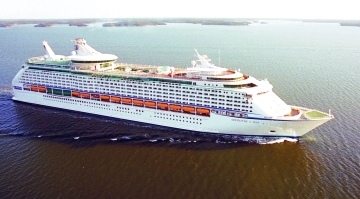 |
Adventure of the Seas
137,300 gt, blt 2001 by Kvaerner-Masa, operated by RC | | CL
| The second-hand market |
|
The second-hand market remained active
for the first nine months of the year, with the most recent ships finding
buyers at very respectable prices. Amongst the most noteworthy sales, we
can cite:
- The 'Star Aquarius' (built in 1989, 40,000 gt, 1,740 passengers)
of Star Cruises sold to DFDS for $75 million, and returning to its
initial vocation as a ferry.
- The 'Victoria' (built in 1966, 28,900 gt, 778 passengers) sold
for $17.5 million by P&O to Italian interests with a charter back
for 18 months.
- The 'Pacific Princess' (built in 1971, 20,600 gt, 610
passengers) sold for $17 million in the same conditions.
- The Fred Olsen group bought the 'Crown Dynasty' for a price of
$65 million (built in 1993, 19,000 gt, 800 passengers) from Effjohn,
which picked up this vessel following the bankruptcy of the Commodore
group.
- The Spanish Pulmann Tours bought the 'Oceanic' (built in 1965,
38,000 gt, 1,100 passengers) for a price of $24 million, following the
bankruptcy of Premier Cruise Line.
- Cunard was able to sell the 'Seabourn Goddess I' and 'Seabourn
Goddess II' (built in 1984 and 1985, 4,260 gt, 116 passengers) for a
combined price of $20 million to a new owner Seadream Yacht Club.
- The 'Hyundai Pungak' (built in 1972, 19,900 gt, 610 passengers)
was sold for about $11 million to a company controlled by G. Herrod,
the previous owner of Orient Line.
- The 'Westerdam' (built in 1986, 53,800 gt, 1,494 passengers) and
the 'Tropicale' (built in 1982, 36,675 gt, 1,022 passengers)
profited from some internal transactions within the Carnival group and
were sold to enhance the Costa fleet.
Since September 11th, the second-hand market has gone quiet, with all
operators waiting for the market to stabilise before investing. It is
however likely that ships built before the 70's and with steam turbines,
will have a problem finding buyers in the future, with clients showing a
preference for the comfort of new or recent ships, which represent the
majority of the fleet (82 % of the fleet expressed in gross tons being
built after 1990). The disposal of the 'Costa Riviera' for scrapping
(built in 1963, 1,000 berths) at the end of the year well illustrates this
tendency.
|
| Consolidation |
|
|
There was further consolidation within the
industry with the announcement of the merger between P&O Princess
Cruises and Royal Caribbean Cruises, thus promoting the largest cruise
group overtaking their big rival Carnival. This new entity with an
estimated worth of $6 billion, owns 41 ships (75,000 berths) and has a
firm orderbook of 12 ships (29,000 berths) to be delivered over the next
three years. It is active in the American market and Northern Europe and
should consolidate its position in Southern Europe. It is for this reason
that the company has already made known its intention of putting four new
joint ships into this market.
Carnival
|
who had remained until then the uncontested world leader as
cruise owner, was unable to let this announcement pass-by without reacting
and immediately improved its offer to the shareholders of P&O to $4.5
billion to entice them to change tack and to join their group. The outcome
of this proposal is unknown at time of press.
These big battles carry with them certain underhand comments and
unpleasant remarks concerning all parties, which helps to destabilise the
financial analysts and undermine their assessments. Is it really necessary
in order to affirm one's presence, to caste aspersions on your
competitors who are all contributing to the cruise market's development
by offering a diversity of products? Surely it is in the interests of
clients, shipyards, and suppliers to keep the market on its course of
expansion, to have a range of companies which each contribute in their
individual and special manner to enlarge and spread a better appreciation
of the cruise industry. We remain extremely confident in its growth (10
million tourists chose to cruise this year, of which 7.5 million in
America - a doubling in 10 years - and nearly 2 million in Europe).
Some observers think that there will be a further doubling in the cruise
passengers number over the next ten years, since this type of leisure is
outstanding in terms of value for money and client satisfaction.
* * *
|
In the uncertain times that we are
experiencing, it is also worth remembering that a ship is a floating
asset, which can be easily transferred to markets out of high risk zones,
unlike hotels and holiday villages which are often at the mercy of local
conflicts. This security aspect is frequently underestimated by the
analysts.
World economic growth, population growth and, as a natural consequence,
the expansion of the leisure industry are essential underpinning reasons
for the development of the cruise market.
This is why we can and should look at the future of this powerful
sector of activity with confidence.
|
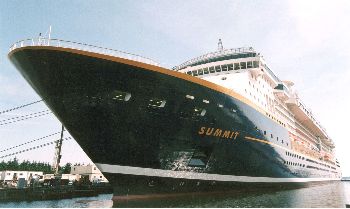 |
Summit
91,000 gt, blt 2001 by Chantiers de l'Atlantique, operated by Celebrity Cruises |
|
Shipping and Shipbuilding Markets in 2001
I N D E X
|